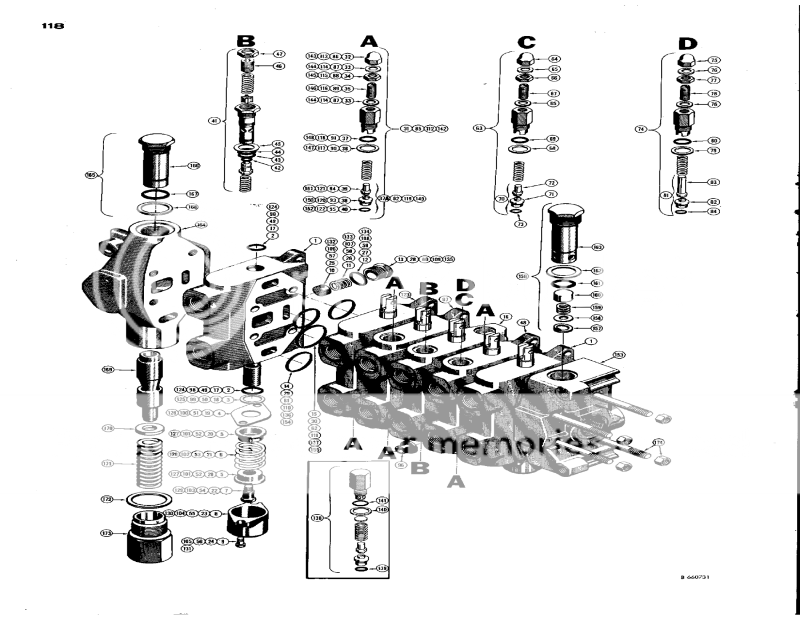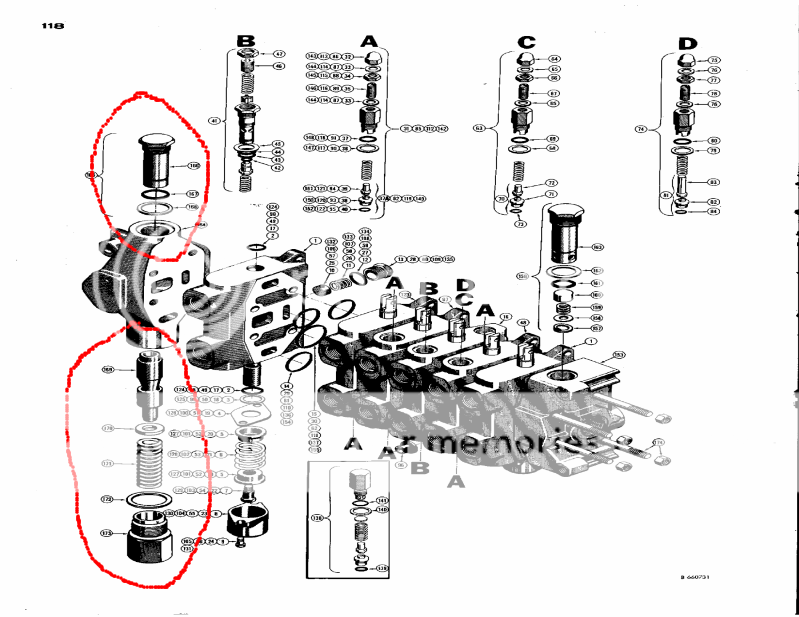Rooster368
Member
First off, sorry for the long post, but I figure when it comes to problem solving….the more information the better.
Well, after giving up on this project for about a year, I am just now getting back around to trying to solve the issue my 530CK has with a lack of power to the Backhoe.
I have a later model 530ck which has the 2 spool loader valve and the backhoe valve block which does not possess an adjustable pressure relief valve (i.e. main pressure relief valve in the loader control valve is for both the front loader and backhoe).
The back pressure tests were conducted per the service manual with the following results:
Front Loader (bucket @ full travel) - 2,200 psi
Backhoe (stabs & bucket @ full travel) - 1,400 psi
I have replaced the beyond power o-rings, checked all my connections, and verified fluid levels.....but for some reason I am still getting low power to the BH.
Not sure what to do at this point.....from my layman’s understanding of how this loader control valve works, it would appear that pump pressure is applied first to the loader spools, then (if neither spool is actuated) fluid then goes to the beyond power plug, which directs it to the BH control valve which (due to its open flow design) sends it back to the sump as long as no spools are actuated.
I currently have the pressure gauge installed in the test port on the side of the loader control valve, but was wondering if there was any benefit to installing it in-line between the beyond power plug and the BH control valve. If my understanding of this hydraulic circuit is correct, then theoretically, I shouldn’t see any pressure differences from that of the test port. However, if I were to dead-end the hydraulic circuit prior to the BH control valve, then I should see the actual line pressure supplied to the BH control valve (without any pressure loss due to the BH control valve).
I guess my thought process is that it the BH supply line pressure is the same as the loader (~2,200 psi), then I know that the problem is in the backhoe control valve; however if the line pressure is still ~1400, then the issue has to be in the loader valve. Does any of this sound logical?
Also would dead ending the BH supply line (for a very short period) cause catastrophic failure to the system, or present a dangerous situation? Is there a better way to determine where my problem is?
Again, thanks for reading all of this, and I appreciate any advice you guys can give me.
Thanks,
Rich
Well, after giving up on this project for about a year, I am just now getting back around to trying to solve the issue my 530CK has with a lack of power to the Backhoe.
I have a later model 530ck which has the 2 spool loader valve and the backhoe valve block which does not possess an adjustable pressure relief valve (i.e. main pressure relief valve in the loader control valve is for both the front loader and backhoe).
The back pressure tests were conducted per the service manual with the following results:
Front Loader (bucket @ full travel) - 2,200 psi
Backhoe (stabs & bucket @ full travel) - 1,400 psi
I have replaced the beyond power o-rings, checked all my connections, and verified fluid levels.....but for some reason I am still getting low power to the BH.
Not sure what to do at this point.....from my layman’s understanding of how this loader control valve works, it would appear that pump pressure is applied first to the loader spools, then (if neither spool is actuated) fluid then goes to the beyond power plug, which directs it to the BH control valve which (due to its open flow design) sends it back to the sump as long as no spools are actuated.
I currently have the pressure gauge installed in the test port on the side of the loader control valve, but was wondering if there was any benefit to installing it in-line between the beyond power plug and the BH control valve. If my understanding of this hydraulic circuit is correct, then theoretically, I shouldn’t see any pressure differences from that of the test port. However, if I were to dead-end the hydraulic circuit prior to the BH control valve, then I should see the actual line pressure supplied to the BH control valve (without any pressure loss due to the BH control valve).
I guess my thought process is that it the BH supply line pressure is the same as the loader (~2,200 psi), then I know that the problem is in the backhoe control valve; however if the line pressure is still ~1400, then the issue has to be in the loader valve. Does any of this sound logical?
Also would dead ending the BH supply line (for a very short period) cause catastrophic failure to the system, or present a dangerous situation? Is there a better way to determine where my problem is?
Again, thanks for reading all of this, and I appreciate any advice you guys can give me.
Thanks,
Rich



